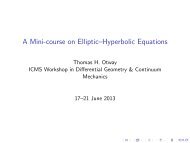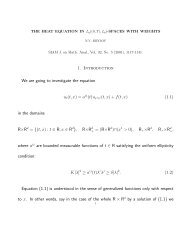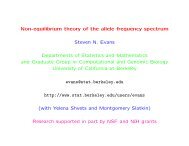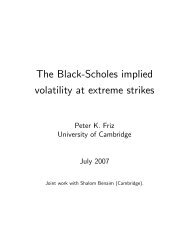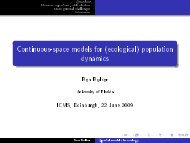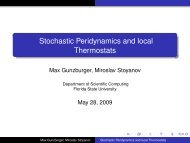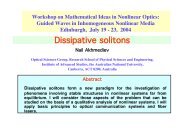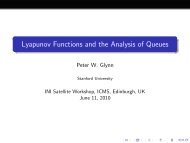Luc TARTAR Compensated Compactness with more ... - ICMS
Luc TARTAR Compensated Compactness with more ... - ICMS
Luc TARTAR Compensated Compactness with more ... - ICMS
Create successful ePaper yourself
Turn your PDF publications into a flip-book with our unique Google optimized e-Paper software.
With H-measures, it is implied by a <strong>more</strong> natural conjecture: if<br />
u n , v n converge in L ∞ weak ⋆ and correspond to a H-measure<br />
µ, then (*) implies that a.e. (x, t)<br />
µ is supported at two opposite points in (ξ, τ).<br />
There seems to be a geometrical idea behind the preceding<br />
calculations, that some 2-forms vanish on K.<br />
In the PDE courses which I taught at CMU, I pointed out to<br />
a pedagogical mistake made by Laurent SCHWARTZ: when he<br />
said that a locally integrable function f defines a distribution,<br />
he called that distribution f, and he should have called it f dx<br />
for emphasizing the role of dx, although in the end of his book<br />
he mentions that there is no natural volume form on a manifold,<br />
and he describes the currents of DE RHAM (1903–1990).<br />
I heard Laurent SCHWARTZ make fun of one of my teachers<br />
in physics at École Polytechnique, Louis LEPRINCE-RINGUET<br />
(1901–2000), who had said that the Hilbert spaces used by<br />
physicists are different from those used by mathematicians.<br />
Laurent SCHWARTZ should have pointed out that for a complex<br />
Hilbert space mathematicians use an Hermitian product (a, b)<br />
which is linear in a and anti-linear in b, while physicists use<br />
the notation of DIRAC 〈c|d〉, which is linear in d and anti-linear<br />
in c, and explain the notation | d〉〈c | for an operator, which<br />
mathematicians denote <strong>with</strong> a tensor product notation d ⊗ c.<br />
DIRAC called 〈c| a “bra” and |d〉 a “ket”, and for H = L 2 a<br />
function f ∈ L 2 is denoted |f〉, while 〈f| is an element of the<br />
dual H ′ , namely f dx.<br />
For V = H 1 0 (Ω) ⊂ H = L 2 (Ω), the canonical isometry of V<br />
onto V ′ is u ↦→ −∆ u, that of H onto H ′ is u ↦→ u dx.<br />
30




